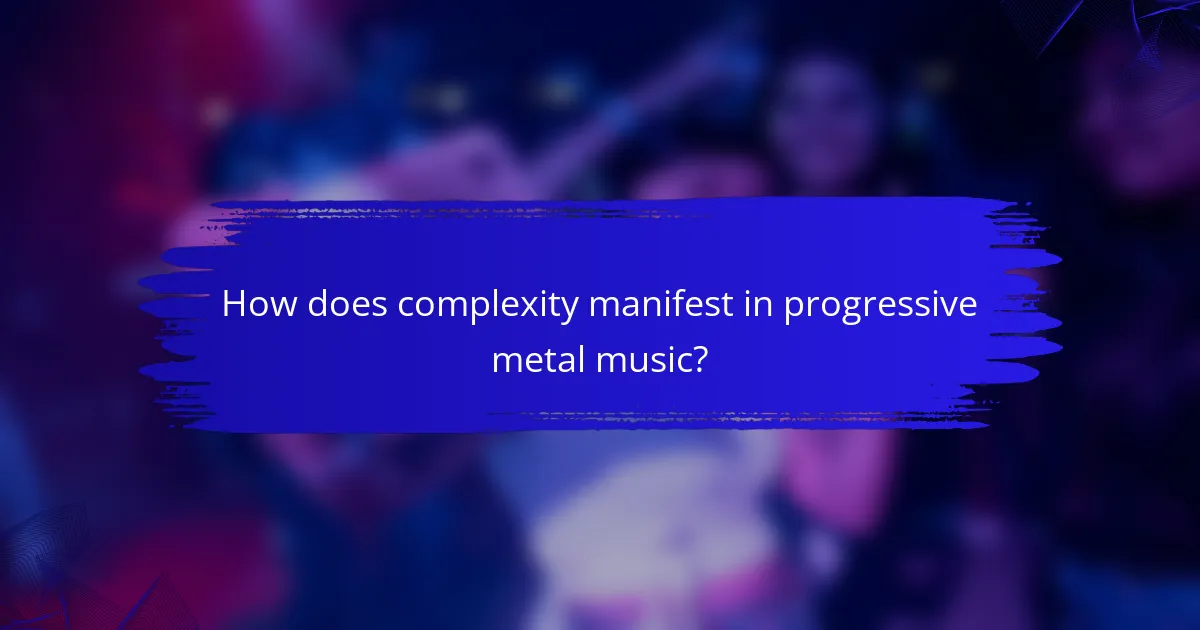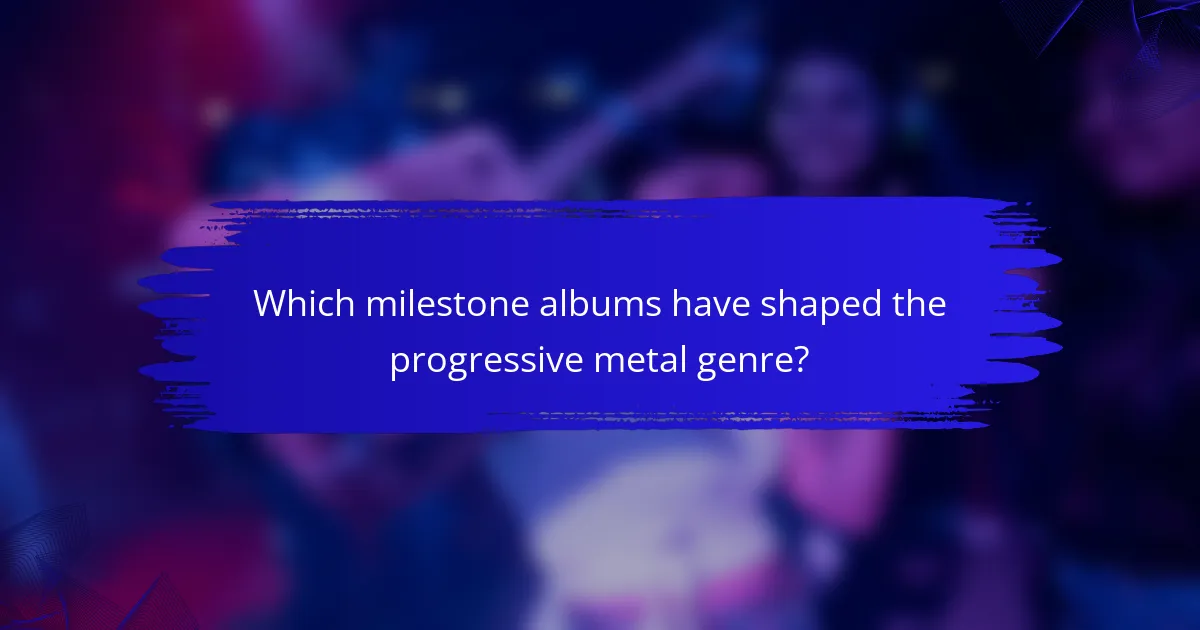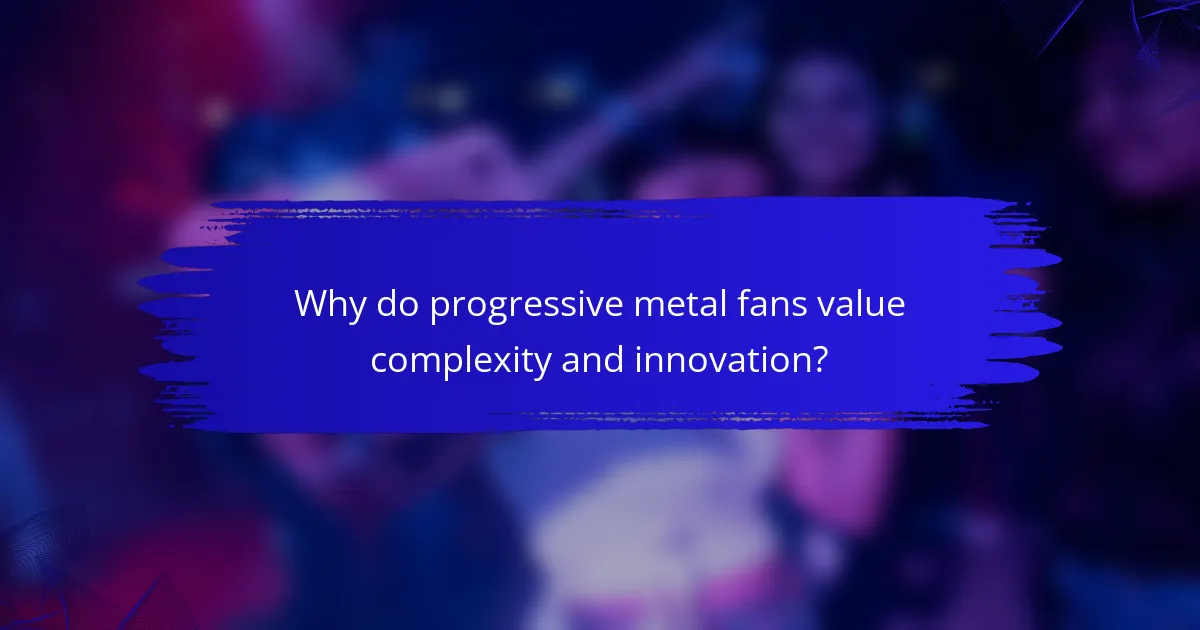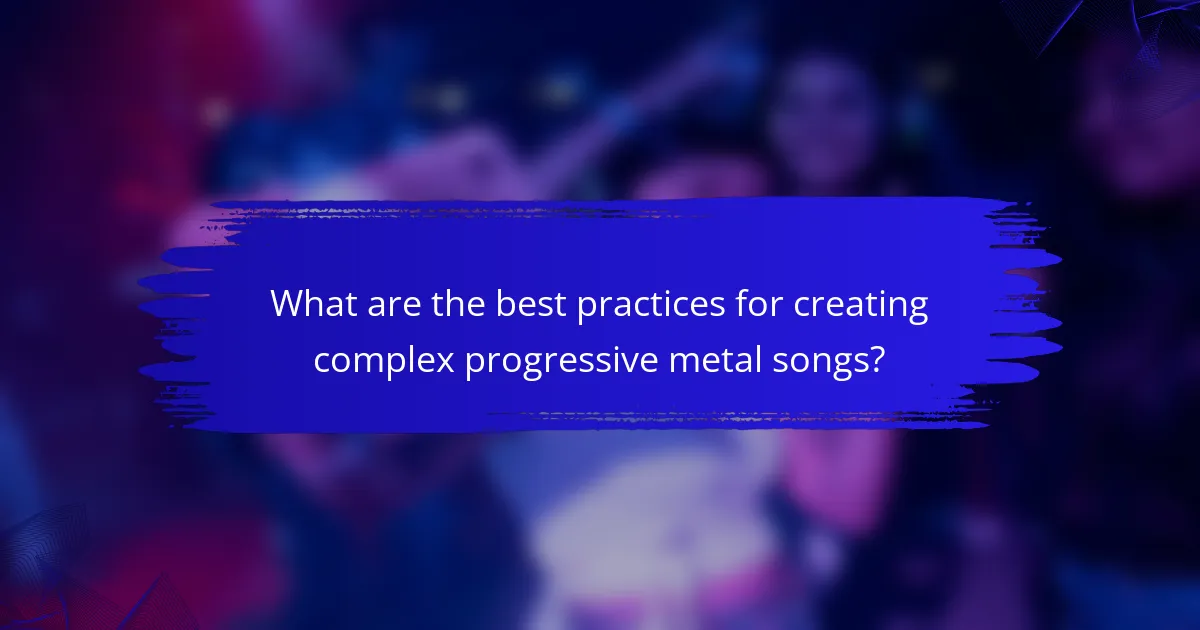Progressive metal is known for its complexity, blending intricate song structures and thematic depth. This article explores the genre’s defining characteristics, the significance of milestone albums, and the innovative techniques that shape its sound. Key examples include “Close to the Edge” by Yes and “Metropolis Pt. 2: Scenes from a Memory” by Dream Theater, which highlight the genre’s unique appeal. Understanding these elements reveals why progressive metal continues to challenge traditional music norms.

How does complexity manifest in progressive metal music?
Complexity in progressive metal music manifests through intricate song structures, time signature changes, and thematic depth. These elements create a rich listening experience that challenges traditional music norms. Milestone albums like “Close to the Edge” by Yes and “Metropolis Pt. 2: Scenes from a Memory” by Dream Theater exemplify this complexity. They showcase diverse musical techniques, including polyrhythms and extended compositions, which contribute to the genre’s distinctiveness.
What are the fundamental characteristics of progressive metal?
Progressive metal is characterized by complex musical structures, intricate time signatures, and thematic depth. This genre often features extended compositions, blending elements from various styles, including jazz and classical music. Milestone albums like “Images and Words” by Dream Theater exemplify these traits, showcasing technical proficiency and innovative songwriting. Unique attributes include the use of unconventional instruments and a focus on conceptual storytelling. Rarely, progressive metal incorporates electronic elements, further enriching its sound.
Which musical techniques contribute to complexity in song structures?
Progressive metal employs various musical techniques that enhance complexity in song structures. Key techniques include polymetric rhythms, irregular time signatures, extended harmonic progressions, and dynamic contrasts. These elements create intricate musical landscapes, allowing for rich storytelling and emotional depth. Milestone albums often showcase these techniques, demonstrating their impact on the genre’s evolution.
How does time signature variation enhance musical complexity?
Time signature variation significantly enhances musical complexity by introducing unpredictability and diverse rhythmic patterns. This complexity engages listeners and allows for intricate song structures, often seen in progressive metal. Unique time signatures, such as 7/8 or 5/4, challenge conventional expectations, creating a distinctive sound. Milestone albums in this genre, like “Images and Words” by Dream Theater, showcase these variations, demonstrating how they contribute to overall musical depth and artistic expression.
What role do unconventional scales and modes play in progressive metal?
Unconventional scales and modes significantly enhance the complexity and depth of progressive metal. They introduce unique tonalities that challenge traditional harmonic structures, creating a more dynamic listening experience. For example, the use of exotic scales, such as Phrygian or Lydian, can evoke distinct emotional responses and add layers to compositions. Milestone albums often showcase these elements, reflecting the genre’s evolution and pushing boundaries. This complexity is a hallmark of progressive metal, distinguishing it from other genres.

What are the defining features of song structures in progressive metal?
Progressive metal features complex song structures characterized by unconventional time signatures, extended compositions, and thematic development. These elements create a dynamic listening experience, often blending various musical styles.
Typical features include multiple sections with contrasting moods, intricate guitar solos, and frequent tempo changes. Milestone albums like “Images and Words” by Dream Theater exemplify these traits, showcasing the genre’s depth and sophistication.
The use of polyrhythms and odd meters enhances complexity, while lyrical themes often explore philosophical or fantastical concepts. This unique blend distinguishes progressive metal from other genres, appealing to listeners seeking musical innovation.
How do typical song forms differ from traditional rock structures?
Progressive metal typically incorporates complex song structures that diverge significantly from traditional rock. Unlike the standard verse-chorus format in rock, progressive metal often features multiple sections, intricate time signatures, and extended instrumental passages. This complexity allows for thematic development and dynamic contrasts, creating a unique listening experience. Milestone albums in progressive metal, like “Images and Words” by Dream Theater, exemplify these structures, showcasing varied tempos and unconventional arrangements.
What is the significance of dynamic contrasts in progressive metal compositions?
Dynamic contrasts in progressive metal compositions create emotional depth and complexity. These contrasts enhance the listener’s experience by juxtaposing heavy and soft sections, resulting in a captivating narrative flow. This technique allows for intricate song structures that often feature unexpected transitions, keeping the audience engaged. Albums like “Images and Words” by Dream Theater exemplify this approach, showcasing how dynamic shifts contribute to the overall atmosphere and storytelling.
How do thematic development and motifs influence song structure?
Thematic development and motifs significantly influence song structure in progressive metal by creating complex arrangements and emotional depth. These elements guide transitions, enhance storytelling, and establish cohesion within tracks. Milestone albums exemplify this complexity, often featuring intricate time signatures and varied dynamics. For instance, “Metropolis Pt. 2: Scenes from a Memory” by Dream Theater showcases how themes interweave through multiple sections, reflecting character arcs and narrative progression. This approach not only captivates listeners but also elevates the overall musical experience, reinforcing the genre’s distinctive identity.
Which role does improvisation play in live progressive metal performances?
Improvisation enhances live progressive metal performances by allowing musicians to explore complex song structures in real time. This spontaneity showcases individual creativity and fosters dynamic interactions among band members. Unique attributes of improvisation, such as unexpected solos and variations in rhythm, contribute to a distinctive live experience. Additionally, improvisation can elevate the emotional intensity of performances, creating memorable moments for audiences.

Which milestone albums have shaped the progressive metal genre?
Milestone albums that have shaped the progressive metal genre include “Images and Words” by Dream Theater, “Operation: Mindcrime” by Queensrÿche, “Metropolis Pt. 2: Scenes from a Memory” by Dream Theater, “Lateralus” by Tool, and “Aenima” by Tool. These albums showcase complex song structures and innovative instrumentation, influencing countless artists. Each album represents a unique blend of technical proficiency and thematic depth, establishing benchmarks in the genre.
What impact did “Images and Words” by Dream Theater have on the genre?
“Images and Words” by Dream Theater significantly shaped progressive metal by elevating complexity and innovative song structures. The album introduced intricate time signatures and dynamic arrangements, influencing countless bands. Its fusion of technical prowess and emotional depth set a new standard for the genre. The unique attribute of seamless transitions between heavy riffs and melodic passages became a hallmark of progressive metal. As a result, “Images and Words” is often regarded as a milestone album, marking a pivotal moment in the evolution of progressive rock and metal.
How did “Metropolis Pt. 2: Scenes from a Memory” redefine narrative in music?
“Metropolis Pt. 2: Scenes from a Memory” redefined narrative in music by integrating a cohesive story throughout its progressive metal compositions. This album features complex song structures that seamlessly blend multiple musical themes, enhancing the storytelling experience. The use of recurring motifs and character development within the lyrics allows listeners to engage deeply with the narrative. Additionally, the album’s ambitious length and intricate arrangements set a new standard for concept albums in the genre, influencing countless artists and redefining expectations for narrative depth in music.
What innovations did “Lateralus” by Tool introduce in song structures?
“Lateralus” by Tool introduced complex time signatures and polyrhythms, revolutionizing progressive metal song structures. The album features a Fibonacci sequence in its lyrical and musical composition, enhancing thematic depth. Additionally, the seamless transitions between tracks showcase innovative arrangements that challenge conventional song formats. These elements together mark “Lateralus” as a milestone in progressive metal.
Which lesser-known albums have made significant contributions to progressive metal?
Several lesser-known albums have significantly contributed to progressive metal, showcasing intricate song structures and innovative compositions. Notable examples include “The Human Equation” by Ayreon, “Colors” by Between the Buried and Me, and “The Great Misdirect” by the same band. These albums feature complex arrangements and thematic depth, pushing the boundaries of the genre. Additionally, “Ocean Machine: Biomech” by Devin Townsend presents a unique blend of melody and heaviness, while “A Pleasant Shade of Gray” by Fates Warning exemplifies seamless transitions between movements. Each of these works has played a crucial role in shaping the progressive metal landscape.

Why do progressive metal fans value complexity and innovation?
Progressive metal fans value complexity and innovation because these elements enhance musical depth and emotional expression. Complex song structures allow for diverse arrangements and intricate instrumentation, creating a unique listening experience. Milestone albums like “Images and Words” by Dream Theater and “Lateralus” by Tool showcase this complexity, featuring unconventional time signatures and extended compositions. Fans appreciate how these innovations challenge traditional music norms and foster artistic growth within the genre.
How does the community perceive the balance between technical skill and emotional expression?
The community often perceives a balance between technical skill and emotional expression as essential in progressive metal. Fans appreciate intricate song structures that showcase musicianship while valuing the emotional depth conveyed through lyrics and melodies. Milestone albums often exemplify this balance, merging complex arrangements with relatable themes. This duality enhances the listening experience, drawing in both technically inclined listeners and those seeking emotional resonance.
What are the common misconceptions about progressive metal music?
Many misconceptions exist about progressive metal, primarily regarding its complexity and song structures. Some believe it is overly complicated, but this genre often balances intricate arrangements with emotional depth. Others think progressive metal lacks accessibility, yet many milestone albums have achieved commercial success. The perception that all songs are excessively long ignores the diversity in song lengths within the genre. Additionally, some listeners assume progressive metal is solely about technical prowess, overlooking its rich lyrical content and thematic exploration.

What are the best practices for creating complex progressive metal songs?
To create complex progressive metal songs, focus on intricate song structures, dynamic shifts, and thematic depth. Utilize unconventional time signatures and explore various musical influences to enhance complexity. Incorporate contrasting sections and motifs to maintain listener engagement. Milestone albums like “Images and Words” by Dream Theater exemplify these elements, showcasing the genre’s potential for innovation and artistic expression.
How can musicians effectively incorporate diverse influences into their compositions?
Musicians can effectively incorporate diverse influences into their compositions by embracing complexity in song structures and drawing inspiration from milestone albums. They should explore various genres, blending elements such as time signatures, melodies, and harmonies. Collaborating with artists from different backgrounds can introduce fresh perspectives. Additionally, studying landmark albums in progressive metal reveals innovative techniques and arrangements that can be adapted into new works. This approach not only enriches their sound but also challenges traditional boundaries, fostering creativity and originality.
What strategies can be employed to maintain coherence in complex song structures?
Employing strategies such as thematic motifs, dynamic contrasts, and rhythmic variation can maintain coherence in complex song structures. Thematic motifs help to create familiarity, while dynamic contrasts engage listeners through varying intensity. Rhythmic variation adds interest and prevents monotony, ensuring each section feels distinct yet connected. Additionally, using transitional elements between sections can enhance flow and coherence, guiding the listener through intricate arrangements.
Which tools and technologies can aid in the production of progressive metal music?
Digital audio workstations (DAWs), virtual instruments, and advanced audio editing software are essential tools for producing progressive metal music. These technologies enable musicians to create complex song structures and intricate arrangements.
Key tools include Logic Pro X, Ableton Live, and Pro Tools, which offer extensive features for recording and editing. Additionally, plugins like Guitar Rig and Superior Drummer provide unique sounds and effects that enhance the genre’s signature complexity.
Milestone albums often utilize innovative production techniques, showcasing the importance of these tools in achieving the desired sound. For instance, Dream Theater’s “Metropolis Pt. 2: Scenes from a Memory” exemplifies how technology can elevate progressive metal compositions.